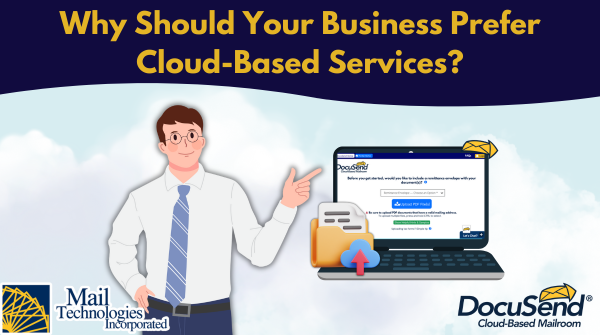Why Should Your Business Prefer Cloud-Based Services?

A few years ago, most of us only used the word “cloud” to describe those fluffy—or sometimes threatening—things in the sky. Now when hearing the word, it’s likely a nebulous concept of the internet will come to mind. So, what’s the big deal? How did this formerly nerdy term come to be a household word even for those who don’t really understand it?
More to the point, why does preferring cloud-based services matter to your business?
Let’s start by exploring what exactly this major technological trend is and then move on to how it simplifies business operations.
The Physical Backbone of the Cloud
In the simplest of terms, the cloud is virtual data storage on the internet, eliminating the need for physical hardware like hard drives or other storage devices. But, although the cloud seems entirely virtual, it relies on real physical infrastructure. For businesses, this eliminates the need to invest in their own servers and maintenance. Physical servers, data storage systems, network equipment, and data centers are maintained by cloud providers such as Amazon Web Services (AWS), Microsoft Azure, or Google Cloud. Virtualization technology creates virtual computing resources (software that emulates the functionality of physical computers), data storage, and networks.
Beyond that, it also includes a suite of tools and services for data management, computations, project management, and even building complex applications. Cloud services are applications and platforms hosted and operated in the cloud.
OK, that’s enough technical stuff—now we’ll look at what’s in it for you, the business owner or manager.
It’s Convenient and Secure
These technologies are so accessible that you can log in to your account from any device anywhere in the world, requiring only a username and password. You can upload documents to the cloud to share or collaborate on them, store large volumes of photos and videos, back up data from phones or computers in real time, and use music and video streaming services—all “in the cloud,” as we say.
For reducing the risk of data loss, there has been nothing like it. “I regret not having this backup option in the past,” said a friend of mine who’s an editor. She now saves everything in the cloud to avoid repeating a situation she once faced. Her hard drive failed, and the data wasn’t backed up in time. After years of editing books, she discovered she couldn’t go back to history—the archive of all her work was lost.
Cloud Tools for Every Need
For businesses, cloud services open up even more possibilities. For example, you can use DocuSend’s cloud-based mailroom to get your letters and invoices automatically printed, without manual work from your side, by uploading them online. Also, you can use Google Workspace or Microsoft 365 for real-time collaboration, and Dropbox or OneDrive for secure storage and sharing of corporate files. There are also specialized cloud-based CRM (Customer Relationship Management) systems like Salesforce or HubSpot that help manage all your customer interactions.
Make Data-Driven Decisions
The cloud can also help businesses make quick and accurate decisions by analyzing large amounts of data. Imagine a retail chain using cloud technology to analyze sales. Every day, stores collect data on purchases, customer preferences, inventory levels, and seasonal trends. This data is sent to the cloud, where powerful analytical tools like Google BigQuery or AWS Redshift process it in near real-time.
What do they get from using these tools? Through analysis, the retail chain can forecast product demand, optimize inventory to avoid shortages or overstock, and create more personalized offers for customers based on their preferences.
Why Tech Companies Place Their Apps in the Cloud
Companies providing Software as a Service (SaaS), including our DocuSend cloud-based mailroom, use cloud platforms for flexibility, security, reliability, and scalability of their services. Efficiency increases, while data loss becomes nearly impossible. Here is why.
While a physical server might fall under a hacker attack, fail, or simply lack capacity during peak periods of high demand, the expansive capabilities of the cloud ensure effective operation regardless of load.
Even if, theoretically, a cloud provider were to be targeted by hackers, it’s highly unlikely that your business data would be compromised. Providers like AWS, Google Cloud, and Microsoft Azure typically use advanced encryption methods, multiple layers of security, backup duplication and recovery processes, and distributed storage systems (i.e., even if one part of their infrastructure is attacked, data can be restored from other copies or storage locations).
How Being Based on Cloud Technology Differentiates DocuSend from Traditional Mailing Providers
DocuSend’s mailroom is based on Amazon Web Services (AWS). Using the power of the cloud, we can offer users these benefits traditional print-to-mail services don’t.
Scalability at Your Fingertips
As you already know, we print and mail your business documents and invoices for you. You just upload them in the cloud, and you’re done. We take it from there, preparing and mailing them via USPS within two business days, saving nearly half your usual mailing costs in the process. Our remarkable advantage is that we don’t require any minimum quantities, nor do we have limits: You can upload one invoice or many thousands. So let’s imagine your business is a startup, and is only just beginning to send mail. Or maybe all you need is to occasionally send a few documents. You can do it right away without waiting to gather a certain minimum usually needed for the automated mailing services. But then you grow and need to scale your business communication. With DocuSend, there’s no need to plan ahead for peak loads or invest in additional resources. It is still the most convenient solution for you due to its flexibility, as it can handle fluctuating volumes. Whether you’re a small business mailing a handful of invoices or a large corporation sending thousands of statements monthly, the system continually adjusts to your needs. You never have to worry about infrastructure limitations.
Pay-As-You-Go Efficiency
DocuSend’s pay-as-you-go model is a game-changer for businesses. You only pay for what you use—no subscriptions, no long-term contracts. It is particularly beneficial for startups and small businesses, which often operate on tight budgets. A startup may need to send invoices sporadically, and paying for access to a service upfront without being sure you will use it up is impractical. With DocuSend, there’s no headache of trying to predict upcoming quantities, so this potential waste of money is eliminated.
Accessibility from Anywhere
Being cloud-based, DocuSend allows you to manage your document processing from any location. Whether you’re in the office, working remotely, or traveling, all you need is internet access. Simply log in and upload your documents.
A business owner or manager on the go, for example, can ensure invoices are sent on time without needing to go to the post office or relying on their staff. There is also an option to share a company account and report portal between multiple users, setting the appropriate level of access for each of them, which is helpful when more than one person on the team is responsible for uploading documents.
Seamless Integration with Your Workflow
DocuSend integrates effortlessly into existing business workflows, requiring no specialized software or training. Because it’s in the cloud, it is fully web-based, and doesn’t require you to install any software or buy any equipment. Uploading documents is straightforward, and the system automatically prepares them for printing and mailing.
For small businesses using software like QuickBooks Online or FreshBooks, DocuSend offers an app that can be connected to their account. It also provides an API that acts as an invisible extension of companies’ existing software, so the end users can eliminate manual labor like printing and stuffing envelopes and mail via USPS with a few clicks.
Therefore, businesses of any size can access a professional solution and leave routine mailing tasks to a trusted, cloud-powered system.
Have you already tried it? Or are you using other cloud services to streamline your business operations? We’d love to hear about your experiences, and how it made your life easier. Share your thoughts in the comment section below.

